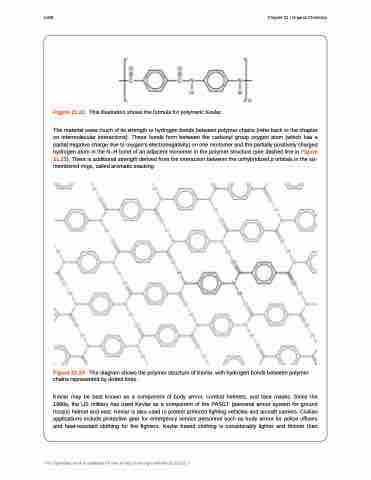Page 1208 - Chemistry--atom first
P. 1208
1198 Chapter 21 | Organic Chemistry
Figure 21.22 This illustration shows the formula for polymeric Kevlar.
The material owes much of its strength to hydrogen bonds between polymer chains (refer back to the chapter on intermolecular interactions). These bonds form between the carbonyl group oxygen atom (which has a partial negative charge due to oxygen’s electronegativity) on one monomer and the partially positively charged hydrogen atom in the N–H bond of an adjacent monomer in the polymer structure (see dashed line in Figure 21.23). There is additional strength derived from the interaction between the unhybridized p orbitals in the six- membered rings, called aromatic stacking.
Figure 21.23 The diagram shows the polymer structure of Kevlar, with hydrogen bonds between polymer chains represented by dotted lines.
Kevlar may be best known as a component of body armor, combat helmets, and face masks. Since the 1980s, the US military has used Kevlar as a component of the PASGT (personal armor system for ground troops) helmet and vest. Kevlar is also used to protect armored fighting vehicles and aircraft carriers. Civilian applications include protective gear for emergency service personnel such as body armor for police officers and heat-resistant clothing for fire fighters. Kevlar based clothing is considerably lighter and thinner than
This OpenStax book is available for free at http://cnx.org/content/col12012/1.7


